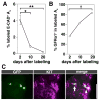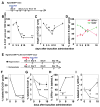Functional hierarchy and reversibility within the murine spermatogenic stem cell compartment
- PMID: 20299552
- PMCID: PMC2981100
- DOI: 10.1126/science.1182868
Functional hierarchy and reversibility within the murine spermatogenic stem cell compartment
Abstract
Stem cells support tissue maintenance by balancing self-renewal and differentiation. In mice, it is believed that a homogeneous stem cell population of single spermatogonia supports spermatogenesis, and that differentiation, which is accompanied by the formation of connected cells (cysts) of increasing length, is linear and nonreversible. We evaluated this model with the use of lineage analysis and live imaging, and found that this putative stem cell population is not homogeneous. Instead, the stem cell pool that supports steady-state spermatogenesis is contained within a subpopulation of single spermatogonia. We also found that cysts are not committed to differentiation and appear to recover stem cell potential by fragmentation, and that the fate of individual spermatogonial populations was markedly altered during regeneration after damage. Thus, there are multiple and reversible paths from stem cells to differentiation, and these may also occur in other systems.
Figures






Comment in
-
Counterfeiting the family jewels.Cell Stem Cell. 2010 May 7;6(5):405-6. doi: 10.1016/j.stem.2010.04.012. Cell Stem Cell. 2010. PMID: 20452312
References
Publication types
MeSH terms
Substances
Grants and funding
LinkOut - more resources
Full Text Sources
Medical
Molecular Biology Databases

